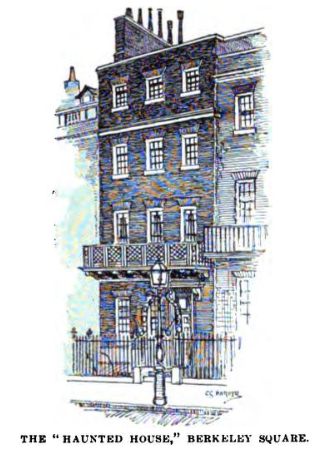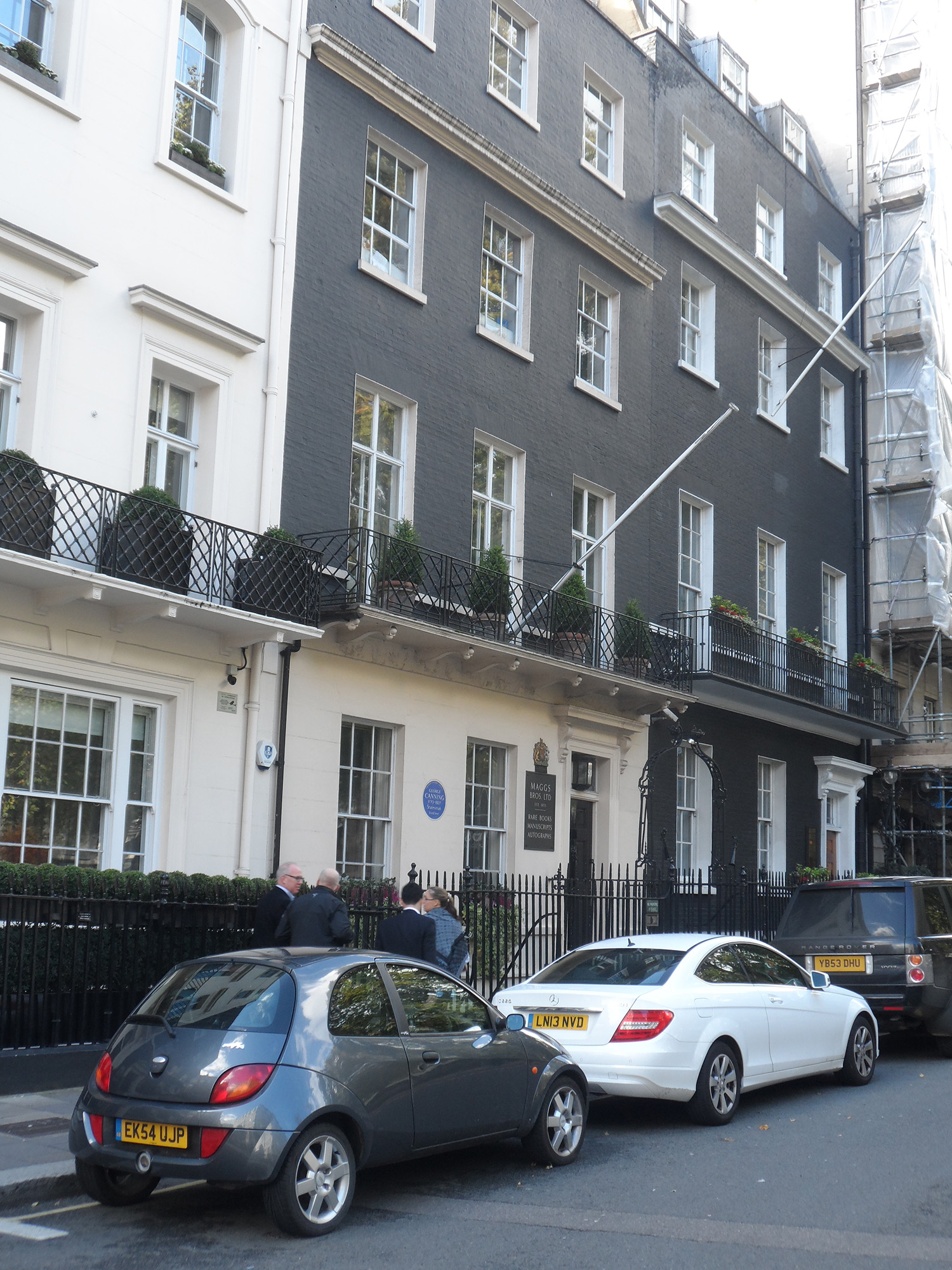50 Berkeley Square on:
[Wikipedia]
[Google]
[Amazon]
 50 Berkeley Square is a reportedly haunted townhouse on
50 Berkeley Square is a reportedly haunted townhouse on
 There were three sets of correspondence about 50 Berkeley Square in the journal ''
There were three sets of correspondence about 50 Berkeley Square in the journal ''
WalksOfLondon.co.uk – 50 Berkeley Square, The Most Haunted House In London
{{coord, 51, 30, 31.8, N, 0, 8, 45.1, W, type:landmark_region:GB, display=title Houses in the City of Westminster Reportedly haunted locations in London Buildings and structures in Mayfair
 50 Berkeley Square is a reportedly haunted townhouse on
50 Berkeley Square is a reportedly haunted townhouse on Berkeley Square
Berkeley Square is a garden square in the West End of London. It is one of the best known of the many squares in London, located in Mayfair in the City of Westminster. It was laid out in the mid 18th century by the architect William Kent, ...
in Mayfair
Mayfair is an area of Westminster, London, England, in the City of Westminster. It is in Central London and part of the West End. It is between Oxford Street, Regent Street, Piccadilly and Park Lane and one of the most expensive districts ...
, Central London. In the late 19th century it became known as one of the most haunted houses in London,Jones, Richard. (2007). ''Walking Haunted London''. New Holland Publishers Ltd: 4th Edition. p. 69 with its attic room said to be haunted by the spirit of a young woman who had committed suicide there.
Researchers have since suggested that the stories may have derived from the odd behaviour of the house's occupant, Thomas Myers, who slept during the day and made unusual sounds in the house at night. Nevill, Lady Dorothy. (1906). ''The Reminiscences of Lady Dorothy Nevill: Edited by Her Son Ralph Nevill ''. London: Edward Arnold. pp. 261–264 Bondeson, Jan. (2015). ''The Most Haunted House in London''. Fortean Times
''Fortean Times'' is a British monthly magazine devoted to the anomalous phenomena popularised by Charles Fort. Previously published by John Brown Publishing (from 1991 to 2001), I Feel Good Publishing (from 2001 to 2005), Dennis Publishing (from ...
. Issue 335, p. 28 It has also been noted that many of the stories about the house were exaggerated or invented by later writers about its ghost
In folklore, a ghost is the soul or Spirit (supernatural entity), spirit of a dead Human, person or non-human animal that is believed by some people to be able to appear to the living. In ghostlore, descriptions of ghosts vary widely, from a ...
s. Roud, Steve. (2010). ''London Lore: The Legends and Traditions of the World's Most Vibrant City''. Arrow. pp. 70–76.
Legend
The legend about the house varies, but most versions state that the attic room of the house is haunted by the spirit of a young woman who committed suicide there. She purportedly threw herself from a top-floor window after being abused by her uncle and is said to be capable of frightening people to death. The spirit is said to take the form of a brown mist, though sometimes it is reported as a white figure. A rarer version of the tale is that a young man was locked in the attic room, fed only through a hole in the door, until he eventually went mad and died. Another story is that the attic room is haunted by the ghost of a little girl who was killed there by a sadistic servant. From 1859 until the early 1870s Thomas Myers, who was rumoured to have been rejected by his fiancée, lived in the house. He lived alone and it was said that he locked himself inside and slowly went mad until his death at the age of 76 in November 1874. During his residence in the house it fell into gross disrepair and its reputation began to develop. It is alleged that in 1872, on a bet, Lord Lyttleton stayed a night in the building's attic. He brought hisshotgun
A shotgun (also known as a scattergun, peppergun, or historically as a fowling piece) is a long gun, long-barreled firearm designed to shoot a straight-walled cartridge (firearms), cartridge known as a shotshell, which discharges numerous small ...
with him and fired at an apparition. In the morning he attempted to find the apparition, but could only find shotgun cartridges. The following year the local council issued a summons to the house's owners for failure to pay taxes, but it is claimed that they were not prosecuted because of the house's reputation for being haunted.
In 1879 a piece in the ''Mayfair Magazine'' alleged that a maid who stayed in the attic room had been found mad and had died in an asylum
Asylum may refer to:
Types of asylum
* Asylum (antiquity), places of refuge in ancient Greece and Rome
* Benevolent asylum, a 19th-century Australian institution for housing the destitute
* Cities of Refuge, places of refuge in ancient Judea
* ...
the day after. It was also alleged that after a nobleman spent the night in the attic room he was so paralyzed with fear that he could not speak.
In 1887 it was alleged that two sailors from HMS ''Penelope'' stayed a night in the house. By morning one was found dead, having tripped as he ran from the house. The other reported having seen the ghost of Myers approaching them aggressively.
Modern interest in the site was spurred by its inclusion in Peter Underwood
Peter George Underwood, (10 October 1937 – 7 July 2014) was an Australian jurist and the Governor of Tasmania from 2008 until his death in 2014. He was the Chief Justice of Tasmania from 2004 to 2008, having been a judge of the Supreme Cour ...
's book ''Haunted London'' (1975).
No phenomena have been reported since the house was bought by the Maggs Brothers in the late 1930s and, though many contemporary media outlets have reported happenings at the house, more recent investigators claim that nothing unusual has ever taken place there. They remark that events in Edward Bulwer-Lytton
Edward George Earle Lytton Bulwer-Lytton, 1st Baron Lytton (; 25 May 1803 – 18 January 1873) was an English writer and politician. He served as a Whig member of Parliament from 1831 to 1841 and a Conservative from 1851 to 1866. He was Secr ...
's story "The Haunted and the Haunters" bear a remarkable resemblance to the supposed hauntings at 50 Berkeley Square.
Sceptical reception
Notes and Queries
''Notes and Queries'', also styled ''Notes & Queries'', is a long-running quarterly scholarly journal that publishes short articles related to " English language and literature, lexicography, history, and scholarly antiquarianism".From the inner ...
'', in 1872–73, 1879 and 1880–81. A common conclusion was that the neglect of the house had inspired the imaginative stories about hauntings.
In her autobiography, published in 1906, Lady Dorothy Nevill
Lady Dorothy Fanny Nevill (''née'' Walpole; 1 April 1826 – 24 March 1913) was an English writer, hostess, horticulturist, and plant collector from the Walpole and Nevill families. She was a founding member of the Conservative Primrose Leag ...
stated that Mr Myers was a relative of hers. After he had lost his fiancée his behaviour "bordered upon lunacy" and he stayed in the house all day, becoming active at night, when he rambled about, making strange sounds. According to Nevill, the "old house would occasionally appear to be lit up at the dead of night". She considered that Myers's nocturnal activities had been misinterpreted by others as evidence of a ghost. She concluded that the haunting had no factual basis and that the "whole story was nonsense".
Modern researchers have suggested that the house was never haunted and that many of the stories were either exaggerated or invented by later writers. For example, the claim that sailors entered the house in the 1870s was invented by Elliott O'Donnell and there is no evidence to confirm any part of the story.
References
External links
WalksOfLondon.co.uk – 50 Berkeley Square, The Most Haunted House In London
{{coord, 51, 30, 31.8, N, 0, 8, 45.1, W, type:landmark_region:GB, display=title Houses in the City of Westminster Reportedly haunted locations in London Buildings and structures in Mayfair